Others
10 Years of Garib Kalyan: Empowering India’s Poor and Marginalized
Posted On: 14 MAR 2024 5:42PM
10 Years of Garib Kalyan: Empowering India’s Poor and Marginalized
(Ministry of Information and Broadcasting)
March 14, 2024
INTRODUCTION
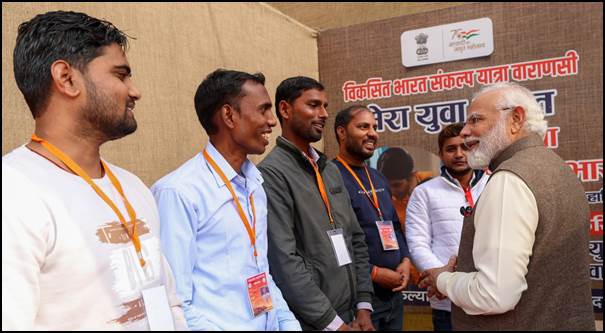
Over the past decade, India’s economic journey has been one of remarkable resilience and progress. Scaling dizzying heights of growth, navigating global storms, and emerging as the fifth-largest economy in the world – the nation’s spirit of hustle, innovation, and ambition is undeniable. But for this growth to be truly sustainable, it needs to be inclusive, bridging the gap between prosperity and marginalization.
Market forces alone often fail to address the deep-rooted challenges faced by the underprivileged. Systemic barriers, limited access to resources, and historical inequalities can trap individuals and communities in cycles of poverty and marginalization. This is where the transformative power of well-designed policies and schemes comes in, acting as a bridge, offering a level playing field, and empowering everyone to not just survive, but thrive.
To address these systemic barriers, the Government of India implemented various policies and schemes over the last ten years. These initiatives targeted the most vulnerable sections of society, focusing on empowering them to break free from cycles of poverty and contribute actively to the nation’s growth.
In the last 10 years, dedicated and consistent efforts have been made to improve the lives and livelihoods of the poor.
- Over 80 crore households receiving free foodgrains every month under Pradhan Mantri Garib Kalyan Yojana
- Over 4 crore pucca houses built under PM Awas Yojana (Rural & Urban)
- 2.8 crore households electrified under the Saubhagya Yojana
- 55 crore beneficiaries targeted with an insurance cover of Rs 5 lakh per family for secondary and tertiary care hospitalization under the world’s largest Government-funded healthcare programme Ayushman Bharat – PM Jan Aarogya Yojana.
- 14.50 crore rural households provided with tap water connections under the Jal Jeevan Mission (as of March 14, 2024)
- Over 10 crore women are now breathing easier, thanks to free gas connections under the PM Ujjwala Yojana.
- Around 12 crore toilets have been built under the Swachh Bharat Mission, bringing dignity and sanitation to millions.
- Around 52 crore Jan Dhan accounts have opened doors to financial inclusion, pulling people into the formal system.
- Over 62 lakh urban street vendors provided with collateral-free loans amounting to around Rs. 11,000 crores under the PM SVANidhi Scheme (as of March 14, 2024).
- 10.04 crore women have been mobilized into 90.76 lakh Self-Help Groups under Deendayal Antyodaya Yojana- National Rural Livelihood Mission (DAY– NRLM) as of March 13, 2024.
More importantly, around 25 crore people have escaped multidimensional poverty in the last nine years – a testament to the effectiveness of various welfare schemes. Additionally, millions have benefited from access to healthcare, skill development programs, and affordable housing initiatives.
As a result, India is likely to achieve its Sustainable Development Goals (SDG) target of halving multidimensional poverty well before 2030. The Government’s persistent dedication and resolute commitment to enhancing the lives of the most vulnerable and deprived have been instrumental in this accomplishment.
However, the journey towards inclusive growth is ongoing. Recognizing the complexities involved, the Government consistently evaluates and updates its interventions to ensure they reach the intended beneficiaries efficiently and effectively.
AFFORDABLE HEALTHCARE
Healthcare access and affordability have long been critical challenges in India, particularly for the underprivileged. However, India has embarked on a transformative journey to make quality healthcare affordable and accessible to its citizens. This journey has been fuelled by several impactful initiatives aimed at strengthening healthcare infrastructure, reducing financial burdens, and delivering quality care closer to home.
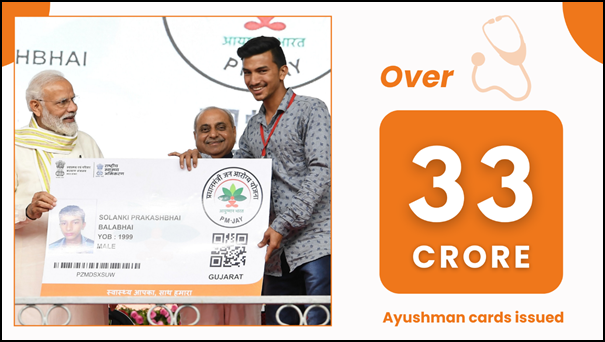
Key Highlights:
- Ayushman Bharat Yojana: The scheme provides health coverage of up to Rs. 5 lakh per family per year for secondary and tertiary care hospitalization to over 55 crore individuals. As of March 14, 2024, 33 crore Ayushman cards have been issued, and more than 6.50 crore hospital admissions worth Rs 81,979 crores have been facilitated. The scheme empowers individuals to seek cashless medical care at empanelled hospitals across the country. This significantly reduces financial burden and ensures timely access to critical treatments, especially for those who were previously unable to afford them.
- Ayushman Arogya Mandir: As of March 13, 2024, over 1.69 lakh primary healthcare facilities have been upgraded to Ayushman Arogya Mandir (erstwhile AB-HWCs), bringing quality healthcare closer to rural communities. Additionally, as of March 13, 2024, over 22 crore patients have availed of e-Sanjeevani OPD services through these centres, offering telemedicine consultations and bridging the gap for those in remote areas.
- Making Medicines Affordable: Recognizing the financial burden of medication, the Government of India has established 11,096 Janaushadhi Kendras (as of March 13, 2024) across the country so far. These pharmacies offer essential medicines at 50-90% cheaper rates compared to market prices, providing significant relief to low-income families by reducing their out-of-pocket expenditures. It is estimated that Pradhan Mantri Bharatiya Janaushadhi Pariyojana (PMBJP) achieved savings of approximately more than Rs. 24,000 crores for the common citizens of the country.
- Combating Deadly Diseases: Initiatives like the National Tuberculosis Elimination Programme have yielded impressive results, with a 16% decline in TB incidence and an 18% reduction in mortality between 2015 and 2022.
- Maternal Health: Under Pradhan Mantri Matru Vandana Yojana (PMMVY), cash incentives are provided directly to the beneficiary via Direct Benefit Transfer (DBT). Under the scheme, over Rs 14,888 crore has been paid to more than 3.32 crore beneficiaries.
By building on these successes, addressing existing challenges, and attracting continued investment in affordable healthcare solutions, India is moving closer to achieving its vision of universal healthcare. This vision doesn't just represent an improved healthcare system; it represents a healthier, more empowered, and equitable future for all, especially the underprivileged communities who have long been on the margins.
SOCIAL SECURITY AND EMPOWERMENT
The past decade has witnessed a remarkable transformation in India’s approach to social security, shifting from short-term interventions to a visionary focus on long-term empowerment and sustainable impact. This shift has resulted in a more capacitating welfare system, laying a solid foundation for human development across the country.
Initiatives like PM Garib Kalyan Anna Yojana (PMGKAY), ensure food security by providing free food grains, PM Ujjwala Yojana provides free cooking gas connections, Ayushman Bharat Yojana offers universal health insurance, Jal Jeevan Mission ensures tap water access, and PM-Awas Yojana guaranteeing affordable housing represent this shift. These programs move beyond immediate relief, building social infrastructure for the future and equipping individuals with the right tools to rise on their own merit.
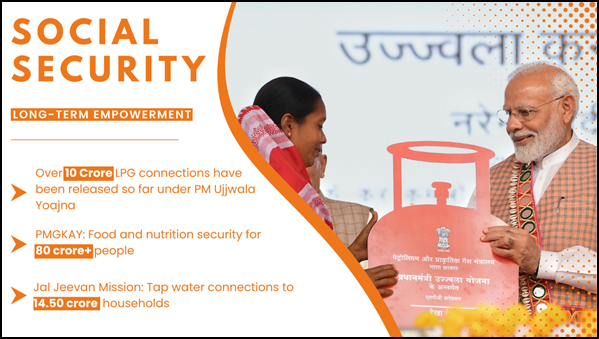
Key Highlights:
- Food Security: PMGKAY is among the World’s biggest social welfare schemes aimed at ensuring food and nutrition security. Under the scheme, over 80 crore citizens are provided free food grains every month. This scheme removes the financial burden of the poor beneficiaries and ensures nationwide uniformity and effective implementation of the National Food Security Act (NFSA).
- Swachh Bharat Mission: Since its inception in 2014, Swachh Bharat Mission - Grameen has constructed around 12 crore toilets and 2.33 lakh community toilet complexes. This widespread sanitation coverage has not only improved hygiene and public health but also empowered women by providing them with privacy and dignity.
- Water Security: From August 2019 to March 2024, India witnessed a remarkable jump in households with tap water connections under the Jal Jeevan Mission, growing from 3.23 crore to an impressive 14.50 crore. Nearly 75% of Indian households now enjoy the convenience and health benefits of having tap water readily available, marking a significant leap forward in access to safe drinking water for millions of citizens.
- Safe and Secure Shelter: The PM Awas Yojana (Gramin and Urban) has addressed the need for affordable housing by constructing 3.31 crore and 81.03 lakh houses for the poor in rural and urban areas respectively (as of March 13, 2024).
- Clean Cooking Fuel: The PM Ujjwala Yojana, launched in 2016, has provided over 10.3 crore LPG connections (as of March 13, 2024), empowering families to switch to clean cooking fuel. This improves respiratory health, reduces drudgery for women, and empowers them to pursue other opportunities.
- Powering Rural Households: Access to electricity is essential for development and well-being. Since the launch of the Saubhagya scheme, it successfully brought electricity to over 2.81 crore previously un-electrified households by March 2021, covering all willing households.
FINANCIAL INCLUSION AND WELFARE
Over the past decade, India has witnessed a remarkable transformation in its approach to financial inclusion and social welfare. By prioritizing access to financial services and providing safety nets for vulnerable populations, the Government has empowered millions of individuals and families, fostering a more inclusive and secure society.
Government initiatives like PM Jan Dhan Yojana bridge the financial gap for the unbanked, while PM Jeevan Jyoti Yojana and PM Suraksha Bima Yojana offer affordable life and accident insurance. Atal Pension Yojana encourages retirement savings, and PM Shram Yogi Maandhan Yojana and PM Kisan Maandhan Yojana provide assured pensions for unorganized workers and farmers.
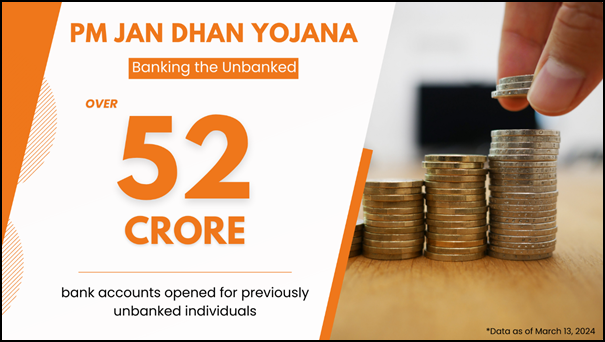
Key Highlights:
- Affordable Life and Accidental Insurance: Understanding the critical need for financial protection, specifically for low-income families, the Pradhan Mantri Jeevan Jyoti Yojana (PMJJBY) and Pradhan Mantri Suraksha Bima Yojana (PMSBY) offer remarkably affordable life and accident insurance. As of January 17, 2024, these schemes have empowered a staggering 19.18 crore individuals with PMJJBY and 42.45 crore with PMSBY, providing their families with a crucial safety net in times of unfortunate events like death or disability.
- Securing the Future: Launched in 2015, Atal Pension Yojana encourages regular savings for retirement, particularly among the self-employed and informal sector workers. With a subscriber base of 6.20 crore (as of January 17, 2024), it empowers individuals to build a corpus for their golden years, ensuring financial independence and dignity in old age.
- Pension for Unorganised Workers: Understanding the challenges faced by unorganized sector workers, PM Shram Yogi Maandhan Yojana, launched in 2019, provides an assured pension of ₹3,000 per month after the age of 60. With 49.7 lakh enrolled (as of December 31, 2023), it offers much-needed social security and peace of mind for millions of workers often excluded from traditional pension schemes.
These social welfare programmes are not just handouts; they are investments in human capital, in futures packed with potential. They are testaments to the power of well-designed interventions to bridge the gap and ensure that India's growth story is truly inclusive, leaving no one behind.
EMPLOYMENT AND SKILL DEVELOPMENT
Over the past decade, India has witnessed a notable transformation in its employment landscape, marked by several positive trends contributing to economic growth and social development. This evolution results from various factors, including economic reforms, technological advancements, and an emphasis on skill development. The slew of structural reforms promoting ease of doing business remains crucial for productive employment generation in the current decade.
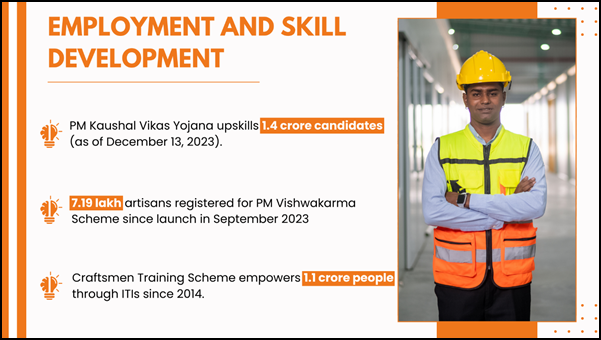
At the heart of this growth story lies the "Make in India" initiative, which has been attracting foreign investment and firing up the engines of domestic manufacturing, creating new jobs. Streamlining regulations and simplifying processes through "Ease of Doing Business" reforms have spurred entrepreneurship and fostered the blossoming of small businesses, further enriching the employment landscape. The digital revolution, championed by initiatives like "Digital India," has ushered in a wave of job opportunities in information technology, e-commerce, and other digital domains.
India's economic rise not only focuses on macro-level statistics but also on empowering its citizens with relevant skills and employability. Over the past decade, a multitude of initiatives have aimed to bridge the skills gap, empower individuals, and unlock their potential for employability and entrepreneurship.
Key Highlights:
- PM Kaushal Vikas Yojana (PMKVY): Launched in 2015, this flagship scheme has trained a staggering 1.4 crore candidates (as of December 13, 2023) across various sectors. By providing industry-relevant skill training and certification, PMKVY equips individuals with the tools they need to secure better employment opportunities and improve their livelihoods.
- Skill India Digital Platform: Launched in September 2023, this platform acts as a one-stop shop for all skill development initiatives in India.
- National Apprenticeship Promotion Scheme (NAPS): With 26.9 lakh apprentices engaged, NAPS provides valuable hands-on experience and industry exposure to young individuals, bridging the gap between theoretical knowledge and practical skills, and preparing apprentices for successful careers.
- Craftsmen Training Scheme: Through ITIs (Industrial Training Institutes), this scheme has imparted training to 1.1 crore individuals between 2014-22.
The narrative of India's progress in the past decade is incomplete without acknowledging the transformative power of skill development on its most vulnerable citizens. The programmes mentioned above act as ladders, helping people climb out of poverty's clutches by giving them all the necessary tools to enhance their employability.
ENTREPRENEURSHIP
The past decade has witnessed a remarkable surge in India's entrepreneurial spirit, driven by a wave of Government initiatives targeting diverse segments of society. These programs have not only nurtured economic growth but also empowered individuals, particularly from marginalized communities, to break free from traditional limitations, build a brighter future, and be in command of their own economic destinies.
Key Highlights:
- PM MUDRA Yojana: The objective of Pradhan Mantri Mudra Yojana (PMMY) is to provide access to institutional finance to new or existing micro units/enterprises up to Rs. 10 lakh. As of January 26, 2024, a total of 46.15 crore loans amounting to Rs. 27.38 lakh crore have been sanctioned under Pradhan Mantri Mudra Yojana (PMMY).
- PM SVANidhi: Recognizing the vital role of street vendors in the informal economy, as of March 13, 2024, PM SVANidhi has sanctioned 86.95 lakh loans and disbursed nearly ₹11,000 crore to more than 62.36 lakh beneficiaries. This empowers them to formalize their businesses, access working capital, and improve their livelihoods.
- DAY-NRLM Mobilizes Women: As of March 13, 2024, 10.04 crore women have been mobilised into 90.76 lakh Self-Help Groups. DAY-NRLM fosters financial inclusion, leadership skills, and collective action among women. This empowers them to participate in economic activities, generate income, and contribute to community development.
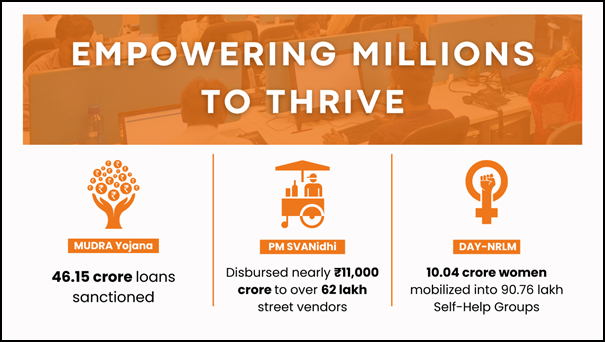
CONCLUSION
A retrospective glance at the last 10 years of the Government of India's efforts to uplift the underprivileged and marginalized paints a picture of significant progress. The past ten years have witnessed a paradigm shift in approach, moving from short-term interventions to a visionary focus on long-term empowerment and sustainable impact. This shift, evident in a plethora of impactful schemes, has laid a solid foundation for inclusive growth and human development across the nation and to ultimately make India a developed country by 2047.
From Swachh Bharat Mission's transformative impact on sanitation to Jal Jeevan Mission's promise of clean drinking water for all, the focus has been on building crucial infrastructure that empowers individuals and communities. PM-AWAS Yojana's affordable housing initiative has provided secure homes, while PM Ujjwala Yojana's free gas connections have improved health and livelihoods. These programs go beyond immediate relief, creating a springboard for future progress.
The emphasis on financial inclusion has been equally transformative. PM Jan Dhan Yojana has brought millions into the formal financial system, while Atal Pension Yojana and PM Shram Yogi Maandhan Yojana offer much-needed social security for the unorganized sector.
Despite certain challenges, the positive impact of these initiatives on the lives of millions is undeniable. They have not just alleviated poverty and hardship but have also empowered individuals and communities to dream bigger and strive for a brighter future. The stories of countless individuals who have broken free from the cycle of poverty thanks to these welfare schemes serve as a testament to the transformative power of well-designed interventions.
References:
Click here to download PDF
*******
Nimish Rustagi/ Himanshu Pathak/ Ritu Kataria/ Saurabh Kalia
(Backgrounder ID: 151873)
Visitor Counter : 9381